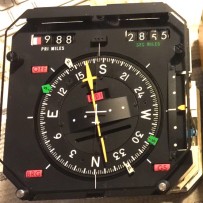Weird Shuttle Crap in Mike’s Place

The space shuttle’s cockpit layout would be instantly familiar to any airline pilot when it came to the many electro-mechanical displays that it used. With the “8-ball” attitude indicator and HSI, or Horizontal Situation Indicator, not to mention many other meters and gauges, the main control panel was gravid with intricate “old school” instruments. Starting in 1998 with Atlantis, the shuttles went through a period of cockpit upgrades to replace the mechanical displays and green-screen vector CRTs with colorful flat-screen video displays. Termed “the glass cockpit” the task was complete with Discovery’s upgrade in 2007.
While the new displays certainly make sense, both from a maintenance and safety standpoint the older displays I just found much cooler than the new ones, (much in the same way a mechanical watch is more interesting than a digital one). After all, the shuttle’s flight deck started to look more and more like my work station, except perhaps the part about the table-cloth and cat…and flowers….and iPads…and lost the exotic spacey feel it once had.
Naturally when the old displays were retired, many someones likely swept them up as souvenirs and I was hoping at some point they might start popping up on the collectors market. Displays would come not only from the shuttles themselves, but from the multitudes of simulators, engineering workstations, flight spares and even malfunctioning units kept for spare parts. Nothing significant floated into view that I was able to find until last April, and I now have it proudly sitting next to me. It supposedly came from one of the shuttle simulators, but nothing to indicate which one.
Called the HSI, or “horizontal situation display,” it is used during landing to ensure the shuttle is on the proper glide slope (important) and heading towards the proper landing site (also important).
The HSI primarily served as a really fancy compass, and is both beautiful on the outside as it is on the inside. Such mechanically intricate pieces of flight hardware is going to be a rarity in the future and it’s nice to have one here that I can examine close up.
Its glass replacement replicates the display, but in pixels only. With the success however, of NASA’s pioneering efforts aircraft companies started their own glass-cockpit upgrades. Next time you board a modern airliner take a peek and you will likely see a half-dozen computer monitors facing the pilots.
The new Orion spacecraft as well as Space-X’s Dragon and latest generation of Russian Soyuz vehicles, likewise carry the “modernized” panels. Interestingly enough, the Shuttle used square displays that bear a superficial resemblance to the ones depicted in the various spacecraft from 2001-A Space Odyssey. But the latter had neater looking graphics. Incidentally, in the film the displays actually had movie projectors behind each one. Imagine how it must have looked behind the main panels in the Discovery’s centrifuge. Not only did they have to get 16 movie projectors running in sync, the projectors had to stay fixed and operating when upside-down!
And of course, the moment I got it, I had to crack open the case to see its innards. And what splendid innards they were.
I am sure this thing cost in excess of 100 bucks (more like $10K or more I bet). And it’s much more interesting then a flat-screen display.

Serial Number 1001
On the side you can see some of the complicated mechanical pieces. A steam-punker’s dream. Except the case would likely be made out of walnut. I also like the minutia in things like this such as the tags on the back. With a serial number of 1001, it looks like I got the first one made.
If anyone has a shuttle ADI available, give me a shot. That’s been on my most-wanted list for a long time. Now back to putting together my full-scale Sputnik model. (really!)







